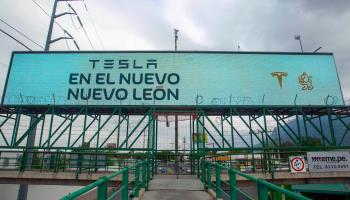Mexico’s new government will try to capitalise on nearshoring trends, but faces challenges in doing so
President Claudia Sheinbaum faces myriad trade and investment challenges in the coming years, relating to infrastructure, energy, security, regulatory frameworks and demands for concessions in numerous areas by US President-elect Donald Trump. She nevertheless looks keen to accelerate Mexico’s nearshoring strategy and boost foreign direct investment (FDI), growth of which was subdued under former President Andres Manuel Lopez Obrador (AMLO).
What next
Subsidiary Impacts
- The nearshoring trend may exacerbate regional inequalities within Mexico, with northern states benefiting more than those in the south.
- Mexico has a competitive workforce but addressing skills gaps would help meet demands of high-value manufacturing and other industries.
- Trump, having been one of the main architects of the USMCA, is unlikely to scrap the agreement, despite his tariff threats.
Analysis
Mexico boosted its share of US imports to 15.4% in 2023, from around 13.4% in 2018, when AMLO’s presidency began. That saw Mexico overtake China as the top exporter to the United States — an impressive feat, but one that has exacerbated US concerns over China using Mexico as a backdoor to circumvent tariffs (see MEXICO: US-China trade role will be substantial – April 5, 2024).
15.4%
Mexico’s share of US imports in 2023
FDI has been resilient, but has not increased dramatically. It remained steady at USD36bn in 2023, aligning with the average for the past decade (see MEXICO: Foreign investor interest will endure – May 30, 2023). Reinvested earnings represented 74% of this amount. AMLO’s policies, nationalising sectors such as energy and advocating industrial self-sufficiency, fuelled investor uncertainty, which likely restrained FDI growth (see MEXICO: Policy ambiguity may hinder nearshoring – March 17, 2023).
Sheinbaum has expressed a desire to attract FDI, not only to foster economic growth, but also to boost social wellbeing.
Investor considerations
Mexico’s proximity to the United States, competitive labour costs and integration with the US-Mexico-Canada Agreement (USMCA) make it an attractive nearshoring destination generally. A global reconfiguration of supply chains, fuelled by geopolitical tensions and the COVID-19 pandemic, has bolstered manufacturing interest in Mexico as an alternative to Asia. Sectors such as automotive production, electronics, medical devices and renewable energy show particular growth potential.
Plans for a Tesla gigafactory in Nuevo Leon illustrate Mexico’s ability to attract high-value manufacturing investments. Although the project has faced delays and challenges since its announcement in March 2023, officials are optimistic about its future. The factory’s estimated investment has tripled to around USD15bn, and it is expected to create thousands of jobs, contributing to the region’s appeal for high-tech industries.
However, drawing similar large-scale investments nationwide will require addressing significant challenges in various sectors, some of which the administration looks more minded to tackle than others:
Energy reliability
Sheinbaum’s shift to renewable energy could draw investors’ attention, reducing costs and improving energy supply stability in nearshoring hubs. Greater renewables capacity will increasingly appeal as companies seek to improve their green credentials, even if Washington de-emphasises the importance such considerations.
Sheinbaum, however, also looks minded to maintain energy policies that favour state firms, limiting private-sector participation and weighing on industrial expansion (see MEXICO: State will dominate electricity sector – November 13, 2024). While those policies could face challenges, particularly as a scheduled 2026 revision of the USMCA nears, concerns around them will endure.
Regulatory stability
The administration has proposed creating a digital agency to simplify bureaucracy, enabling investors to navigate Mexico’s legal frameworks more efficiently. This measure is intended to foster a transparent, predictable investment climate and bolster Mexico’s competitiveness vis-a-vis other US nearshoring hubs such as Central America.
Part of the reason for creating the agency, however, is that recent judicial reforms have raised concerns among business leaders about legal security, which could negatively impact Mexico’s nearshoring attractiveness (see MEXICO: Judicial reform will hit investor confidence – September 17, 2024).
Sheinbaum’s vocal support for these reforms suggests they will remain largely unchanged under her presidency, and although completion of judicial elections next year might help to provide a greater sense of stability for investors, the scheduling of further such elections for 2027 could perpetuate uncertainties.
USMCA compliance
Adherence to USMCA provisions will be important in maintaining investor trust, but with the agreement due to be reviewed in 2026, what exactly those provisions will be two years from now is unclear. Uncertainty could tempt firms to delay major investments until the review is complete.
Policies perceived as favouring domestic companies over foreign counterparts could prompt challenges under the USMCA, and although the agreement actively provides channels through which to pursue such challenges, too many of them could deter future investments.
Transportation
Insufficient transportation infrastructure, particularly in southern states, hampers logistics efficiency and limits access to global markets.
The government seems to acknowledge this. Its 2025 budget provides for major investment in railway infrastructure and, on December 5, it announced its intention to invest nearly MXN33bn (USD1.6bn) in modernising six ports (see MEXICO: 2025 budget may prove too optimistic – December 5, 2024).
High-profile projects such as the Tehuantepec Isthmus Interoceanic Corridor will not only improve transport links, but also help to boost Mexico’s profile as a leading nearshoring destination.
The government is planning an expansion of rail infrastructure
Road infrastructure currently seems less of a priority for the government, however, and ensuring the security of transport links will pose difficulties, with issues such as cargo theft enduring (see MEXICO: Cargo theft to rise – November 15, 2017).
Public security
Insecurity more generally poses ongoing challenges. This does not tend to deter major companies from investing or operating in Mexico, and may not weigh significantly on overall FDI figures (see MEXICO: Insecurity will barely affect Mexico’s FDI – July 23, 2015). However, it does feed into considerations around staff welfare, reputational risks, security spending and insurance costs and could therefore deter smaller potential investors.
Industrial parks
Another project that the government hopes will boost Mexico’s attractiveness to investors involves the development of 100 new industrial parks, at least 92 of which have reportedly already secured permits.
According to the Mexican Association of Private Industrial Parks (AMPIP), the initiative may exceed its initial target, potentially developing 128 parks over Sheinbaum’s six-year term. The USD9bn investment tied to the project could double with further development of energy and water infrastructure, creating conditions for sustained growth and generating up to 350,000 jobs.
In 2024 alone, AMPIP members are set to have invested USD4bn. However, continued enthusiasm for the project may depend to some extent on how trade US relations fare with Trump back in the White House.
The Trump factor
Trump’s return is generating substantial uncertainty that looks likely to affect Mexico’s nearshoring prospects, at least for the next year or so.
Trump’s return to the White House could make some investors nervous



